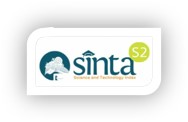An Analysis of Biology Oral Communication Skills and Cognitive Learning Outcomes: The Impact of Practicum-Based Two-Stay Two-Stray Learning Model
Abstract
Oral communication skills and cognitive learning outcomes are indicators of learning achievement. This research aimed to analyze students' oral communication skills and cognitive learning outcomes through the implementation of practicum-based TSTS. This research employed the quasi-experimental method with a pretest-posttest control group design. The samples were determined using the purposive sampling technique. The results showed that the practicum-based TSTS learning model contributed to students' oral communication skills with excellent categories. Teaching and learning activities using the practicum-based TSTS affected students' cognitive learning outcomes (Sig. 0.838> 0.05). Thus, this research showed that the implementation of the practicum-based TSTS learning model on the Plantae topic can train students’ oral communication skills and affect their cognitive learning outcomes.
Keywords
Full Text:
PDFReferences
Boyanton, D. 2014. Redefine "good" dicussion in higher education. The International of Learning in Higher Education. Vol. 20 (4): 39-49.
Crebert, G., Patrick, C. J., Cragnolini, V., Smith, C., Worsfold, K., & Webb, F. 2011. Teamwork Skills Toolkit. Diambil November, 14, 2019.Erdoğan, V. 2019. Integrating 4C Skills of 21st Century into 4 Language Skills in EFL Classes. International Journal of Education and Research. Vol. 7(11) : 113 – 124.
Hernawati, D., Maulina, D., Fitriani, R., & Rizal, R. P. 2020. Bio-literacy perspective: A study of the implementation of outdoor learning-based science process skills in plant introduction. Jurnal Bioedukatika. Vol 8(1) : 31 – 37.
Irwati, H., Susiolo, M., J., & Aprilia, N. 2016. Peningkatan Oral Activities Dan Hasil Belajar Mahasiswa Melalui Model Pembelajaran Two Stay Two Stray Pada Mata Kuliah Development Of Students Pgmipa-U Pendidikan Biologi Universitas Ahmad Dahlan Yogyakarta Tahun Akademik 2014/2015. Proceeding Biology Education Conference (Issn: 2528-5742). Vol 13(1): 503-508.
Lie, A. 2002. Cooperative Learning. Gramedia. Jakarta.
Maulina, D. 2015. Pemahaman Konsep Belajar Melalui Model Pembelajaran Inkuiri. Jurnal Pendidikan MIPA Universitas Lampung. Vol. 5 No. 2.
Maulina, D., Hernawati., Rakhmawati, I., Lengkana, D., & Fauzisar, A, S. The Effect of Inquiry Laboratory with Group Discussions Method on Improving of Students’ Learning Outcomes. Jurnal Pendidikan MIPA. Vol 20 (1): 1-6.
OECD. 2018. OECD Learning Framework 2030.
Patacsil, F.F. & Tablatin, C.L.S. 2017. Exploring the Importance of Soft and Hard Skills as Perceived by IT Internship Students and Industry: A Gap Analysis. JOTSE : Journal of Technology and Science Education. Vol 7 No 3 : 347-368.
Perta, P, A., Ansori, I., & Karyadi, B. 2017. Peningkatan aktivitas dan kemampuan menalar siswa melalui model pembelajaran siklus belajar 5e. Jurnal Pendidikan dan Pembelajaran Biologi. Vol 1(1) : 72-82.
Rakhmawati, Z., Saptorini., & Soepradjo.2012. Pengaruh Model Pembelajaran Three Stay Two Stray berbasis Inquiry Terhadap Hasil Belajar. Chemistry in Education. Vol.2(1): 154-59.
Rhedana, W. 2019. Mengembangkan Keterampilan Abad Ke-21 Dalam Pembelajaran Kimia. Jurnal Inovasi Pendidikan Kimia. Vol 13, No 1 : 2239 – 2253.
Safitri, A. 2015. Pengembangan Modul Kimia SMA Berbasis Inkuiri Terbimbing Pada Materi Larutan Penyangga. Skripsi. Universitas Negeri Semarang, Semarang.
Wahyuni. 2011. Penerapan Model Pembelajaran Two Stay Two Stay sebagai Upaya Meningkatkan Keaktifan Siswa. Skripsi. Universitas Muhamadiyah Surakarta. Surakarta.
Wardhani, I. Y., Sajidan., & Maridi. 2012. Penerapan Model Pembelajaran Kooperatif Tipe Two Stay Two Stray Disertai Media Audio-Visual Untuk Meningkatkan Kualitas Pembelajaran Biologi Siswa Kelas Xi Ipa 5 Sma Negeri 7 Surakarta Tahun Pelajaran 2011/2012. Pendidikan Biologi. Vol. 4, No. 1, hal 40-55.
Gronlund, N.E. & Linn, R.L. (1990). Measurement and evaluation in teaching. (6thed.). New York: Macmillan.
Effendi, S. (1982). Unsur-unsur penelitian ilmiah. Dalam Masri Singarimbun (Ed.). Metode penelitian survei. Jakarta: LP3ES.
Daniel, W.W. (1980). Statistika nonparametrik terapan. (Terjemahan Tri Kuntjoro). Jakarta : Gramedia.
Suyanto, S. (2009). Keberhasilan sekolah dalam ujian nasional ditinjau dari organisasi belajar. Disertasi, tidak dipublikasikan. Universitas Negeri Jakarta.
Pritchard, P.E. (1992). Studies on the bread-improving mechanism of fungal alpha-amylase. Journal of Biological Education, 26 (1), 14-17.
Wafi, M. R. (2014). Olah data penelitian pendidikan.
Puspita, L. (2015). Pengaruh Model Pembelajaran Creative Problem Solving Berbantuan Maple II Terhadap Kemampuan Pemecahan Masalah Matematis. Biosfer: Jurnal Tadris Biologi, 91-98.
DOI: http://dx.doi.org/10.24042/biosfer.v11i2.7451
Refbacks
- There are currently no refbacks.
Copyright (c) 2020 Biosfer: Jurnal Tadris Biologi
License URL: https://creativecommons.org/licenses/by-sa/4.0

















